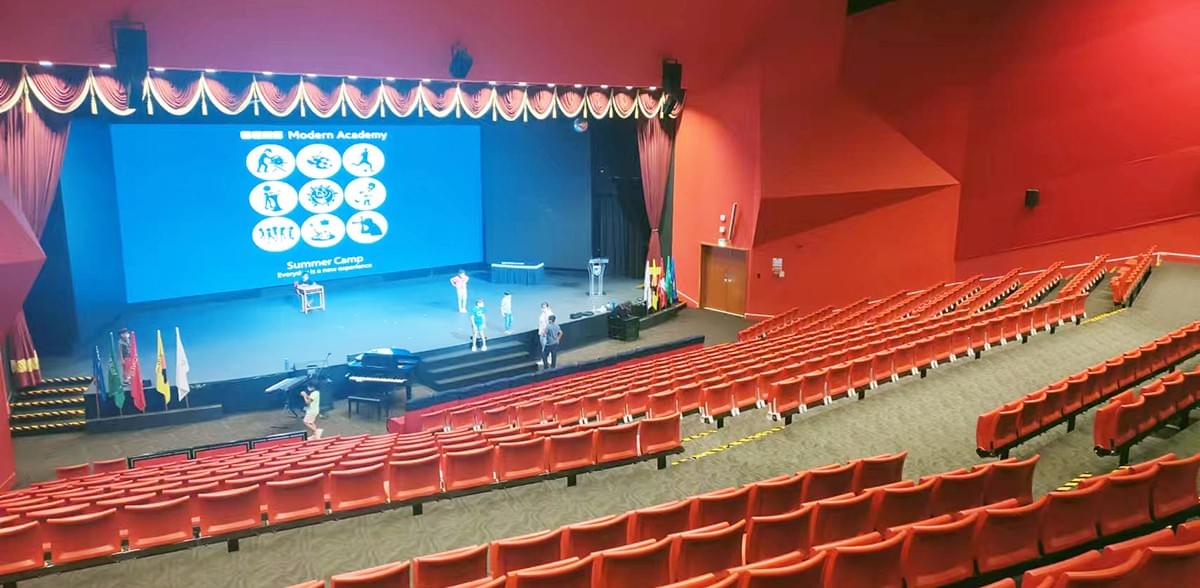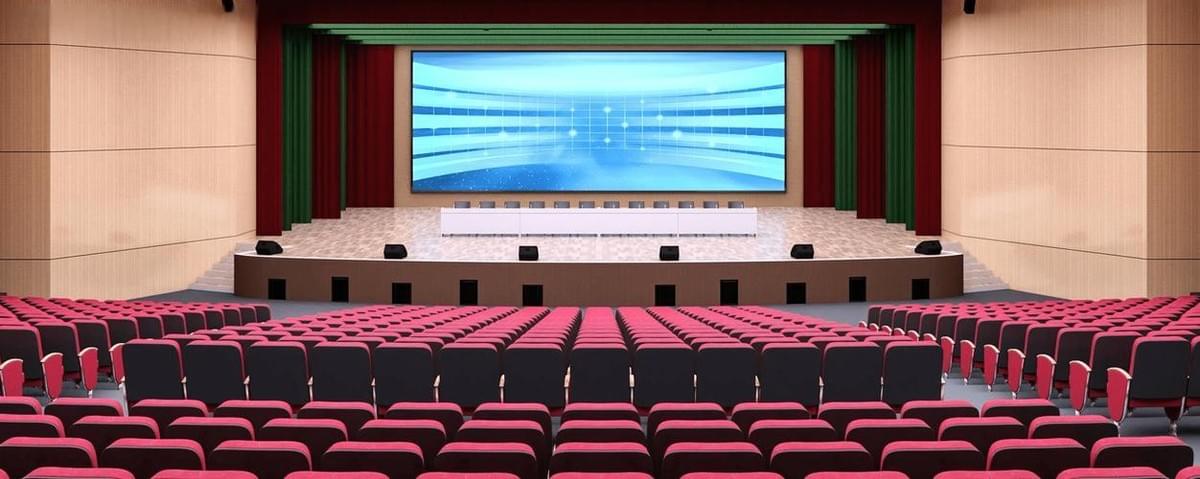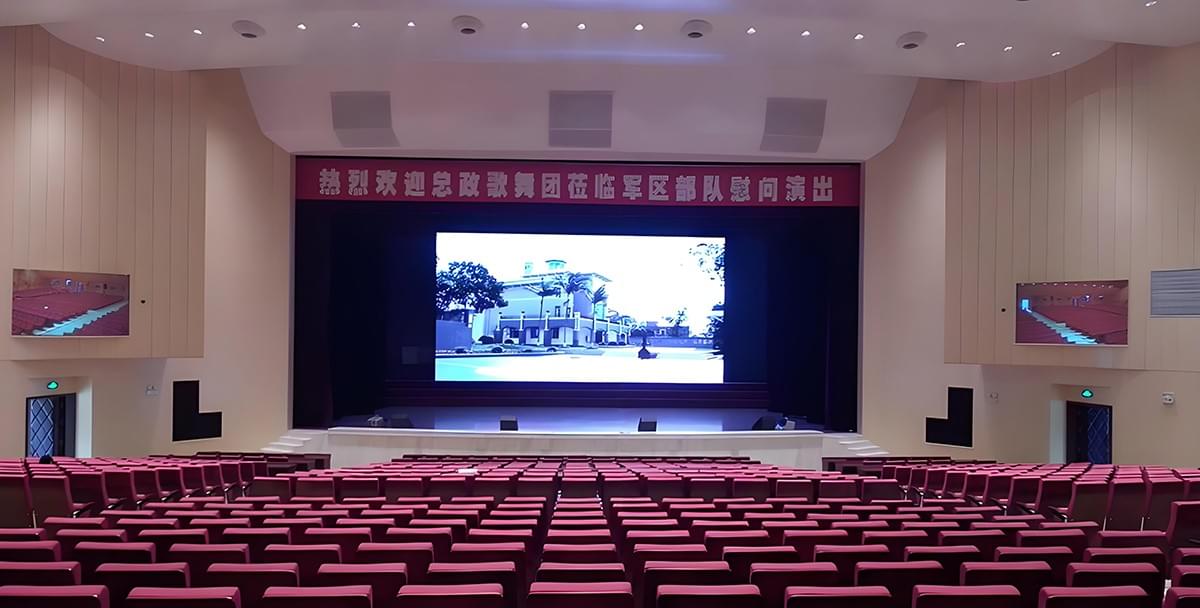An auditorium is a specially designed space that allows audiences to comfortably enjoy performances, presentations, and various events. Typically found in entertainment venues, community centers, and theaters, auditoriums serve multiple purposes, including rehearsals, performing arts productions, and educational activities. Choosing the appropriate LED display is essential for any auditorium, whether it's intended for educational, corporate, or entertainment purposes. The right LED screen significantly enhances audience engagement and satisfaction, playing a pivotal role in elevating the overall experience. Modern auditorium LED screen not only meets but surpasses contemporary visual presentation standards, redefining audience expectations for visual experiences in large venues.
Unlike traditional display methods such as LCD screens and projections, auditorium LED screens utilize thousands, or even millions, of tiny LEDs to create a seamless, high resolution image. Each LED functions as an individual pixel, contributing to the overall picture with its precisely controlled color and brightness. This advanced technology ensures that images remain vibrant and clear, even when viewed from various angles or at considerable distances, without any loss of detail or color fidelity. As a result, LED screens deliver a superior visual experience that enhances the overall impact of any event.
The following table briefly introduces the differences between LED screens, LCD screens and projections.
What are the features and advantages of LED display in auditorium?

1. High Resolution and High Definition
Auditorium LED screens support a wide range of resolutions, including customizable options, delivering exceptional clarity and detail. From standard 1080P to advanced 8K and beyond, higher resolutions enable the display of intricate image and video details, ensuring maximum impact and visibility for every seat in the auditorium.
Please click the below "Button" and check the blog for "LED Screen Sizes in Standard Resolutions 720P, 1080P, 2K and 4K".
2. High Refresh Rate
A high refresh rate ensures smooth, seamless and flicker-free visuals, making auditorium LED screens ideal for displaying high-quality, high-resolution content. To meet modern demands, refresh rates of 3840Hz or even 7680Hz are often required, particularly for large-scale video presentations.
3. High Contrast Ratio and Wider Color Gamut
With high contrast ratios and a wide color gamut, auditorium LED screens can display subtle color gradations between dark and light areas without distortion or loss of detail. LED displays with a wide color gamut, preferably covering at least 85% of the DCI-P3 color space, deliver more realistic and natural colors. However, color accuracy should also be verified, as some screens may have a wide gamut but poor calibration.
4. High Brightness
High brightness in auditorium LED screens ensures clear and vivid visuals in various environments and lighting conditions. This feature guarantees that images remain vibrant and engaging, regardless of ambient light, enhancing the overall viewing experience.
5. Wide Viewing Angle
With viewing angles of up to 170 degrees, auditorium LED screens ensure that audiences receive a consistent, high-quality viewing experience from any seat in the venue. This feature eliminates visual distortion and ensures everyone enjoys the same level of detail and clarity.
6. Superior Image Quality
Thanks to precise control over individual LEDs, auditorium LED screens deliver exceptional brightness, contrast, and color accuracy. This results in crisp, vibrant visuals under any lighting conditions, making presentations more immersive and engaging. Whether displaying subtle backgrounds or intricate video sequences, LED screens bring creative visions to life with unparalleled clarity.
7. Easy to Install and Maintain
Auditorium LED screens typically feature a modular LED panel design, allowing for flexible configurations to suit different spaces and requirements. This modularity simplifies installation, enabling quick setup times. Additionally, individual LED panels can be easily replaced or serviced, minimizing downtime and ensuring uninterrupted operation for critical events.
8. Customization
Customized LED screens offer unique visual experiences tailored to the auditorium's specific needs. They can be designed to fit any size, shape, or curvature, and seamlessly integrated with other elements like lighting, sound, and stage design. This flexibility fosters creativity and enables the creation of immersive, interactive experiences for audiences.
9. Dynamic Content Management and Versatility in Content Display
Auditorium LED screens excel in dynamic content management, effortlessly switching between live feeds, real-time camera shots, pre-recorded videos, and animations. This versatility allows event organizers to craft engaging, interactive experiences. For example, conferences can incorporate live polls, social media feeds, or video content into presentations, making information more accessible and engaging.
10. Energy Efficiency
Despite their impressive display capabilities, LED screens are more energy-efficient than traditional display technologies. This efficiency reduces operational costs and supports eco-friendly initiatives, making them a sustainable choice for modern auditoriums.
What to consider when purchasing LED displays for auditorium?

1. The Layout of the Auditorium
The layout of the auditorium plays a critical role in determining the optimal size, shape, and positioning of the LED screen. Key factors to consider include:
- The dimensions, height, and viewing distance of the LED screen to ensure optimal visibility.
- Seating capacity and arrangement to guarantee clear sightlines and comfortable viewing angles for all audience members.
- Acoustic, lighting, and ventilation conditions, as these can impact both the performance and installation of the LED screen.
2. Screen Size
The size of the LED screen directly affects resolution, cost, and overall visual impact. It should be proportionate to the auditorium’s scale to ensure clarity and immersion. Larger LED screens are generally recommended, as they improve visibility for viewers seated farther away.
Please click the below "Button" and check the blog for "Screen Sizes and Resolutions".
3. Control Room
The distance between the LED screen and the control room is a crucial factor. We recommend using a Synchronous Control System with a powerful video processor for auditorium LED displays. This system requires a direct cable connection between the control hardware and the screen during operation.
Please click the below "Button" and check the blog for "LED Display Control System".
4. The Budget and Resources of the Auditorium LED Screen Projects
The budget and resources allocated to the project will influence the quality and scale of the LED screen. Key considerations include:
- The cost, availability, and reliability of the LED screen.
- Installation, operation, and maintenance requirements.
- The level of technical support and after-sales service provided by the supplier.
Final Recommendations
When planning an LED display installation for an auditorium, it’s essential to address the unique requirements and challenges of the space. By carefully considering the layout, screen size, control room setup, and budget, you can ensure a seamless and impactful installation.
If you have any questions or need assistance with your auditorium LED display project, please don’t hesitate to contact us. We’re here to help you design and implement a solution that meets your specific needs and enhances your audience’s experience.
Why choose our company?
Our company specializes in providing high quality LED displays that offer the best image quality, vivid color reproduction, and clarity. With our competitive pricing and exceptional customer service, we are dedicated to delivering reliable and innovative display solutions to meet all of your needs. Choose us for the best in LED displays technology, and experience the dynamic and powerful way to communicate with your audience.


